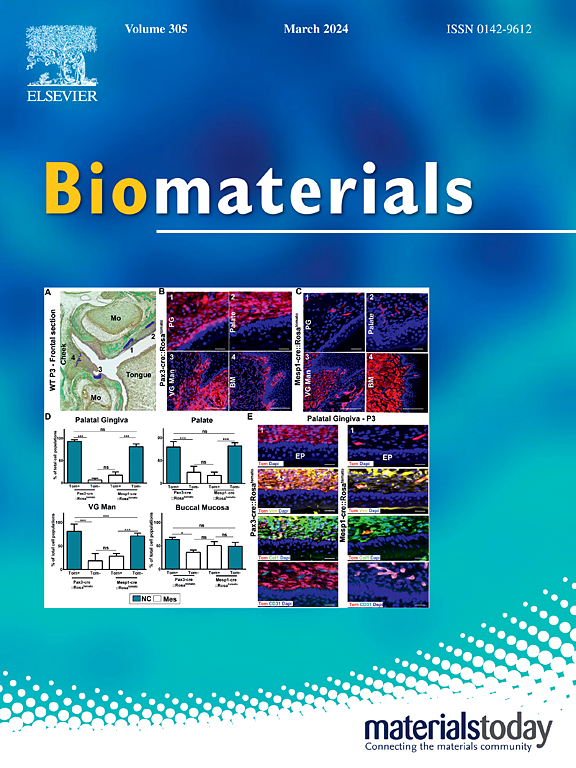A Di-aptamer-functionalized scaffold promotes bone regeneration by facilitating the selective retention of MSCs and EPCs and then promoting crosstalk between osteogenesis and angiogenesis
IF 12.8
1区 医学
Q1 ENGINEERING, BIOMEDICAL
引用次数: 0
Abstract
The crosstalk between osteogenesis and angiogenesis plays an important role in promoting the formation of a microenvironment that supports bone regeneration. This suggests that the retention of endogenous osteogenic and angiogenic cells in the bone defect area can promote tissue-engineered bone (TEB) osteogenesis and cell–cell interactions. In this study, a Di-Aptamer-functionalized HA/β-TCP (Di-Aptamer-H/T) scaffold was prepared by sequential modification of APTES and sulfo-SMCC and connected with aptamer HM69 and EPC1. We confirmed that aptamers HM69 and EPC1 can specifically identify mesenchymal stem cells (MSCs) and endothelial progenitor cells (EPCs), respectively. This process triggers the expression of adhesion-related genes in these cells and allows these cells to selectively stay coupled to Di-Aptamer-H/T. The osteogenic differentiation ability of MSCs treated with Di-Aptamer-H/T in vitro was significantly increased. Similarly, the ability of Di-Aptamer-H/T-treated EPCs to form blood vessels was also enhanced. Notably, the osteogenic and angiogenic abilities of cocultured MSCs and EPCs treated with the Di-Aptamer-H/T scaffold were significantly better than those of cells cultured individually. In vivo, the results of micro-CT angiography, H&E staining, Masson's staining and histochemical staining further confirmed that Di-Aptamer-H/T formed new bones and vessels more readily than those treated with a single aptamer linked to HA/β-TCP or with HA/β-TCP alone. In brief, our study demonstrated that crosstalk between osteogenesis and angiogenesis is promoted by the Di-Aptamer-H/T scaffold, which serves as a potential treatment strategy for bone defects and can improve outcomes.
求助全文
约1分钟内获得全文
求助全文
来源期刊

Biomaterials
工程技术-材料科学:生物材料
CiteScore
26.00
自引率
2.90%
发文量
565
审稿时长
46 days
期刊介绍:
Biomaterials is an international journal covering the science and clinical application of biomaterials. A biomaterial is now defined as a substance that has been engineered to take a form which, alone or as part of a complex system, is used to direct, by control of interactions with components of living systems, the course of any therapeutic or diagnostic procedure. It is the aim of the journal to provide a peer-reviewed forum for the publication of original papers and authoritative review and opinion papers dealing with the most important issues facing the use of biomaterials in clinical practice. The scope of the journal covers the wide range of physical, biological and chemical sciences that underpin the design of biomaterials and the clinical disciplines in which they are used. These sciences include polymer synthesis and characterization, drug and gene vector design, the biology of the host response, immunology and toxicology and self assembly at the nanoscale. Clinical applications include the therapies of medical technology and regenerative medicine in all clinical disciplines, and diagnostic systems that reply on innovative contrast and sensing agents. The journal is relevant to areas such as cancer diagnosis and therapy, implantable devices, drug delivery systems, gene vectors, bionanotechnology and tissue engineering.
 求助内容:
求助内容: 应助结果提醒方式:
应助结果提醒方式:


